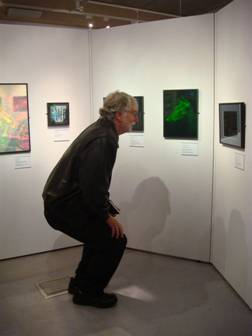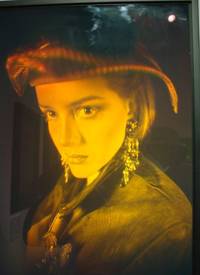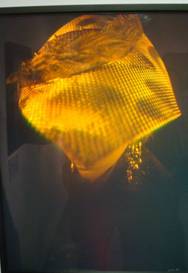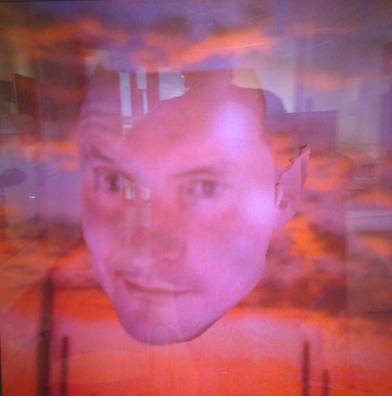
Holography: The First 60 Years
A Review
Holographers, the makers of holograms, and holography enthusiasts share a dream in common, that their segment of optics will someday recapture the position in the technology and public mainstream that it occupied in the 60’s and 70’s. The arrival of lasers in 1961 made holography practical, creating a rush of enthusiasm and ingenuity among scientists, artists and technocrats who seized the opportunity to be first to exploit the new medium. The applications seemed endless, including improved scientific measurements, art, entertainment, advertising, and security of banknotes, credit cards and ID documents. The public, now saturated with what is now almost universally and mistakenly thought of as holography, give as little thought to the glimmer of colours interplaying on their MasterCard as they do to the image of the Queen on their penny.
Jonathan Ross, often introduced as “not the Jonathan Ross of television fame”, has produced a much needed compilation, and has bravely made a play to capture the interest and admiration of a new audience. Holograms-The First 60 Years brings together a heterogeneous collection of exhibitors and their work, ranging from early scientific breakthroughs, through innovative and exciting artistic applications, and including items of popular interest and so-called collectables. He displays the entire history of holography in a meandering display through one room with the goal of attracting and educating the widest possible audience.
Ross, who could be described also as, the Saatchi[1] of holographic art, owns the greatest single private collection of holographic art and collectable holograms in the world and is possibly holography’s most avid promoter. Having presented holograms from his collection in many exhibits for over twenty years, he knows how to optimize their display and which ones to choose for specific audiences, tasks that often are done poorly. This makes him uniquely qualified to produce a traveling exhibition illustrating the history of holography with venues including Banbury (1 March to 5 May), Woodstock (17May to 6 July), Rugby (6-31 August), and Aylesbury (6 December-31 March 09). Ross has successfully produced an exhibit designed to educate and entertain very wide audiences with the history and uses of holography.
I visited the Banbury museum in April to review his latest choice of pieces and to see how he had handled the difficult job of showing holograms to the general public. The purpose of this review is to provide a brief analysis and description of the exhibit with the intention of helping a viewer to better understand and enjoy what he will see in the exhibit. The emphasis here is on holographic art in the exhibit.
Holograms are unlike any other visual medium in the way they should be displayed, described, and viewed. Compounding this difficulty is the vast range of unrelated subjects and genres that can be included in a general holography exhibit. Holograms-The First 60 Years includes a medley of art, advertising, security, identification, engineering, hobbies, collectables, and toys, produced by professional artists, amateurs, hobbyists, industry, and publishers. Encountering some of the world’s greatest works of holographic art next to some of the corniest gimmicks and successes and failures in holography can be overwhelming and confusing for viewers who don’t distinguish the different genres. In addition, the holographic art in the exhibit covers a vast array of art styles, including abstract, representational, kitsch, pop, and several of the isms. An analogous exhibit would include art by Monet, Van Gogh, Damian Hurst, Rembrandt, Andy Warhol, and the kid next door, mixed in with framed objects, cards, comic books, games, collectible coins, toys, and more. Each genre has its own history, its own heroes, and its own audience, and it would be helpful for visitors to understand this.
Holograms can have a restricted angle of viewing presenting a unique display problem. When mounted for children and/or visitors confined to wheelchairs to view (as was done at Banbury), a tall person must stoop to view them as I had to, while my much shorter wife could view most of them quite comfortably. For a few six footers, this could be highly disconcerting if not aware of the problem at the outset. Good museum hosts, like those in Banbury, made sure that we knew about what is referred to in the trade as the hologram viewers’ waltz, a dancing movement to experience all the different views. Doing the stoop-styled waltz had me exhausted by the end of the exhibit. (But it was worth it.)


Hologram Viewers’ Waltz Generally, mainstream art critics have snubbed holographic art, refusing to recognize it as a significant art form and disregarding it at every opportunity. To be fair, this lack of understanding and appreciation is in part due to the newness of holographic art, which is about 35 years old. Other misunderstandings and association with gimmickry and cuteness also cause a problem. Even so, this snubbing would seem especially ironic to anyone who has visited the Tate Modern to see what IS considered “fine art” by the art community. When an unmade bed is touted as art, how can a hologram be rejected?
There are at least a dozen art pieces in the exhibit, any one of which, alone, would be worth your visit. One piece not to miss is what I would call the “ Mona Lisa” of holographic art, Lucy in a Tin Hat by artist Patrick Boyd. This piece sets the bar in holographic representational art, and serves as an excellent example of what a real artist can achieve with the medium. While the exhibit contains 13 holographic portraits of varying excellence, Lucy is much more than simply a holographic portrait; she is a holographic art masterpiece. The three figures here, taken from the hologram, are meant only for guidance and in no way simulate the experience of viewing the hologram.



Lucy in a Tin Hat-Hologram by Patrick Boyd
Boyd exploits at least three features of great holographic art, 1) an excellent technical quality, 2) excellent artistic strategy and esthetics, and 3) outstanding exploitation of the holographic medium to achieve what cannot be achieved by other art forms. This would be a great portrait even if it were two dimensional, but we have just begun to look, and we are already intrigued and may not even consciously know why. Boyd’s composition exploits features unique to holography in addition to the traditional art “tricks”. An art piece such as Lucy does not happen by accident; it takes knowledge, talent, design, planning, creativity, good equipment, probably a lot of failed attempts and also luck. This piece is successful not simply because it is a good hologram; it is successful because Boyd has integrated and successfully exploited the medium of holography with good art practice. Hologram copies of this piece can be purchased for about 2000 pounds. For a more complete critique of this piece see Lucy in a Tin Hat-A Critique.
The exhibit includes several pieces of the same genre as Lucy, such as Margaret Benyon’s Tigirl, Jeffrey Robb’s My Great Aunt, and others, covering a wide range of artistic achievement.
The exhibit provides examples of several methods of both true and pseudo color holography[2]. True color holograms can be seen in the exhibit, for example, in Butterflies by Yves Gentet, and Russian Egg by Hans Bjelkhagen. These holograms illustrate the difference between art holography and holography, since they are archival recordings and their primary function is to record 3D information for viewing. This in no way minimizes the technical achievements; color holograms of this quality are a rare treat.
The exhibit includes a wide range of abstract art, and a viewer needs to shift gears to enjoy these. Abstract art lends itself to a much wider range of holography types, since color and imagery can be handled in a different way. Ken Harris’ Lightman is an excellent example of what I would classify as abstract expressionism and one of my favorites. The piece exploits the pure light features of holography to create an explosion of colors. Holography enables extreme colors with higher temperature and intensity than any other medium. By strategically mixing hot and cool colors, he is compounding the dimensional power of holography with a completely different art technique for pushing images backwards and forwards. This is a very entertaining piece, the kind of art that would provide a center of conversation in a room where it hangs. Spend a few minutes moving around it, enjoying it, and allowing your imagination to run wild.

Lightman by Ken Harris
The exhibit contains at least a dozen other notable abstract pieces, some of which are very beautiful.
Another notable piece is Martin Richardson’s Digital Head, a self portrait. It represents the integration of holography with digital image processing and yet another type of color procedure. This type of holography enables the production of large holograms, and a few more can be seen in the exhibit.

Martin Richardson’s Digital Head
The holograms in the exhibit include pieces that are historically significant as well as pieces by award winning artists. This is consistent with the historical theme of the exhibit.
Other holography applications in the exhibit are gathered in a few cabinets, and they provide a means to show visitors that holograms are on currency, stamps, credit cards, comic books, and many commercial products. Most of these are embossed holograms, produced today in the billions and used in all kinds of security, advertising, and trinkets to get attention. The general public’s association of holograms like these used to produce something cute or bizarre with holographic art tends to cheapen the art, an extremely unfortunate consequence for the art community. “Since they are all holograms, doesn’t that make them all the same thing?”
Another problem haunting holography is that many people associate anything 3D with holography when it may not be. A special cabinet is devoted to non holography, 3D imaging methods, pointing out to viewers that not everything that provides a 3D effect is holography.
The challenges to produce an exhibit like Holography-the First 60 Years were major, and the overall result is an outstanding achievement, including fine examples of holograms of almost every type produced during the first era of holography. The museum hosts described it as a great success for the Banbury Museum, drawing large enthusiastic crowds. Hopefully, it will help elevate the public understanding and appreciation of holography as a wide ranging medium with many applications in our society. Many viewers will leave the exhibit with a new excitement for the medium, and an unfortunate few will leave without the foggiest idea of what they have seen.
The exhibit has moved on to its Woodstock venue, and Ross has incorporated improvements and helpful changes learned from the Banbury experience.
An extremely useful website describes the exhibit in great detail serving as an excellent tool to augment its understanding and enjoyment. http://www.jrholocollection.com/gallery/special/60years/index.html